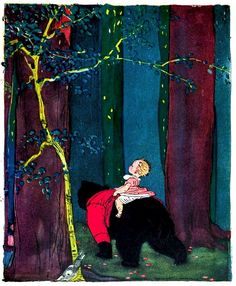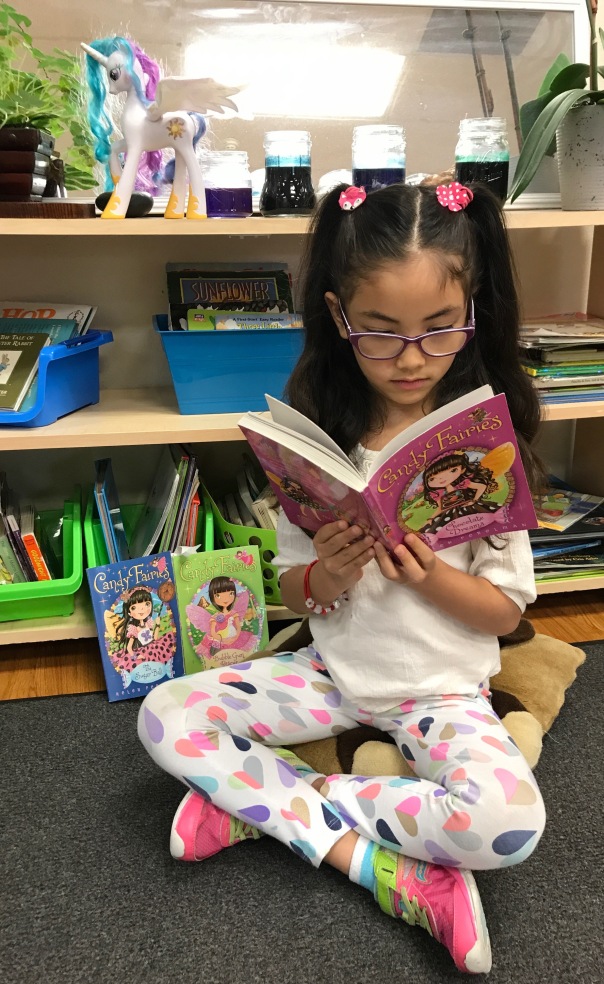
One of the earliest books ever read to me was Honey Bear by Dixie Wilson (1923), illustrated by Maginel Wright Barney. As a very young child I was mesmerized, both with the rhyming story and the exquisite illustrations-the dusky velvet sky, the deep lavender shadows, Honey Bear in his rumpled rose colored jacket…
*
Once upon a summer in the hills by the river
Was a deep green forest where the wild things grew
There were caves as dark as midnight
There were tangled trees and thickets
And a thousand little places where the sky looked through
*
Later, as an adult, I read Algonquin Publishing’s introduction to their series of books for children:
“The makers of Sunny Books believe that books for children should be not only entertaining, but conform to the highest ideals of beauty in book-making, so that the fortunate child who owns them will develop good taste in reading and in art.”
Fortunate, indeed, I was, to fall so completely and sweetly in star dusted love with literature long before I could read.
When choosing first books for your child, be aware of the quality of both writer and illustrator. There is deeper enchantment in the reading of a story when both artists work in harmony with respect and passion for their material.

The Mad Hatter: “Have I gone mad?”
Alice: “I’m afraid so. You’re entirely bonkers. But I’ll tell you a secret. All the best people are.”
Alice in Wonderland has been illustrated by many artists over the years. But, the original black and white John Tenniel drawings reflect best the oddness and dreaminess of Lewis Carroll’s masterpiece. Carroll was a visual artist as well as a writer and knew the importance of the illustrator’s contribution to the integrity of the story. He could have chosen among dozens of children’s book illustrators adept at depicting whimsical fairylands. Instead he chose the acerbic Tenniel, known for his wicked sense of humor and grotesque political cartooning. The choice is intriguing and telling.
My mother often told me the story about how, when she was a little girl, she would sneak down into her grandfather’s library after everyone was asleep and read. Late at night, in the shadows of the dark room, she was both spellbound by Alice’s adventures and terrified by Tenniel’s drawings. A fact that, I’m sure, both gentlemen would have appreciated.

Piglet: “How do you spell ‘love’?”
Pooh: “You don’t spell it…you feel it.”
In a similar close relationship, A.A.Milne worked with Ernest H. Shepherd to create the charming Winnie the Pooh books. Together they capture the elusive innocence of a young child’s long golden days at play…the simple drawings a metaphor for the zen like simplicity of the characters. Disney’s much commercialized renditions, with their artificial cuteness that have turned Pooh from a humble sage to a bumbling clown, are loud, garish, and awkward when compared to the delicate and sensitive drawings of the original illustrator.

Charlotte’s Web would still be a classic without E.B.White’s collaborator Garth Williams’ illustrations, but has anyone else ever drawn Wilbur, Charlotte, Fern, or the well meaning Mr. & Mrs. Arable with greater humor, compassion, gentleness, and love? This is a difficult book emotionally as its principal theme is suffering and death. Yet Charlotte’s story shimmers with hope. Williams’ tender black and white illustrations attend to the sacredness with which the author sees life and death.

But Charlotte,” said Wilbur, “I’m not terrific.”
“That doesn’t make a particle of difference,” replied Charlotte. “Not a particle. People believe almost anything they see in print. Does anybody here know how to spell ‘terrific’?”
In cases in which a wonderful writer is also an accomplished illustrator, such as the works of Maurice Sendak, Rudyard Kipling, or William Blake, the reader is twice blessed with this deeper plunge into the original story creator’s mind. The fantastical fracas of Sendak, the exotica of Kipling, and the metaphysicality of Blake are omnipresent; as much in each brushstroke as in each word.

“It is such a mysterious place, the land of tears.”
Although Antoine de Saint-Exupery never considered himself a visual artist, who can help but fall in love with the earnest Little Prince? The spareness of Exupery’s watercolors perfectly express the underlying message of his simple yet profoundly wise moral tale. And although I agree with The Little Prince that “What is essential is invisible to the eye”, it is often through, not only our reading and uses of imagination, but through our contemplative gaze that the invisible is revealed to us, clear, in all its squalor and glory.
***
“Let The wild rumpus start!”
Maurice Sendak
Where the Wild Things Are

